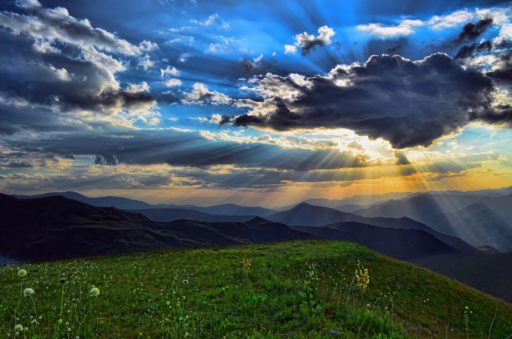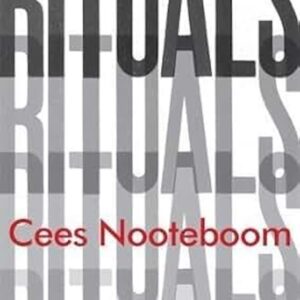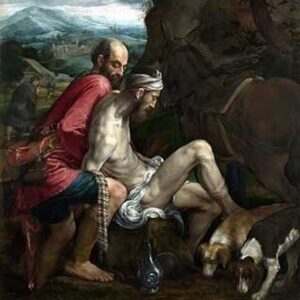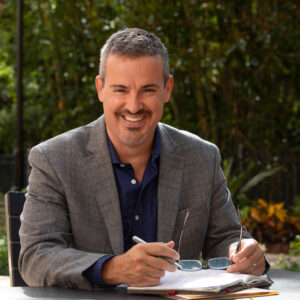Warm sunshine streaming down, a few white clouds fleeting overhead. The squirrels are fighting, the birds diving about: in the evening now we hear robins. Spring has sprung; it’s in the air, if not yet covering the ground in much color here in lower Michigan. I look up from my laptop as I type this, look to the west and into the breeze, and see my sons at the edge of the yard. A large yew stands there, against the chain link fence and between pines and spruces. The boys often go into the yew. It’s a fort for them or any number of things the exact description of which is tricky: various improbable combinations of fire stations and boats, sometimes a kind of airship or a flying tractor. Do they ever think of it simply as the shrub that it is? But what would that mean, the scientific description of Taxus canadensis?
I see that my boys have become frozen, staring into the yard, at the house and at me sitting at the table writing these words. Their play has halted for a moment and they seem to be purely perceiving. Well, that can’t be right. Much is going on inside them that is only, at best, partially communicable or discernible. Is that part of their perception? Their consciousness is surely full of many things, some outward and some inward, that can’t be separated perfectly from each other any more than the sight I have of them now can exclude the yew they’re half-hidden within. Call the total moment, for each of them, an image: a kind of scene populated by a thinking, feeling, sensing human figure (or two).
Now they are moving again, shouting, shaking the branches. I wonder if their pause just now has become for them the sort of thing I’ve just called an image. That is, I wonder if it has become the kind that gets buried in your consciousness inextricably to forever guide the formation of new images. My boys are very young, and the images they are storing up now are not very complex as narratives—at least not if they’re anything like the ones I can recollect from that stratum of my consciousness. But I wonder if such images are ever very story-like; sometimes I wonder if the whole kaleidoscope of such images we amass over our lives make up a story at all.
And that leads me to wonder whether the book sitting on the table here, its cover lifting in the breeze, is a story. It is billed as a novel. It is a moving and beautiful book, called The Hills Reply, the final novel published (in 1968) by the Norwegian author Tarjei Vesaas. I love Vesaas’s other books that I’ve read: they (like this one) meet my desire for literary works that explore the way our consciousness lives in landscape or place and the way the landscape or place lives in our consciousness. But this last book of the author’s fascinates me more than the others because of its form. It is a series of images—as I have just used the term, these moments of consciousness-in-place that become character-defining—a kaleidoscope of them (that word means a sequence of beautiful images)…but do they add up to a story? If so, what or whose story?
The narrator of The Hills Reply goes unnamed. Sometimes he speaks in the first-person, sometimes he appears as the subject of third-person narration. But if this is a story, it is the story of the narrator. There are portraits of his mother and father, and a few other human figures emerge briefly in this pageant of visionary moments in the remote Norwegian countryside: the boy plowing a logging road in the depth of winter with his father and a lone horse, who suffers a terrible wound and sings a song; the boy out on a marsh in early spring, witnessing the return of migrating cranes and their strange dance; the boy, now an adolescent, encountering a girl and beholding her transfigured by snow; the boy, now a lost and alienated young man, gazing into a river and letting himself fall in and drift with the current, almost drowning, all day—it is from this piece that the title (in this edition) of the volume comes, for in his agony and desperation the youth cries out and he hears that cry echo: “The hills reply.”
There are many other scenes, moments, images, some symbolic, some fantastical or dreamlike: recollection of mother and father and the girls on the farm; daybreak and a herd of luminous horses streaming over the hills—but are they just the first sunlight sweeping by? And maybe the most poignant: a wakeful night when the narrator, older now, lies awake imagining an ocean outside his storm-battered house as memories from every season of his life invade his heart and fill it to overflowing.
The language of The Hills Reply, more like prose poetry than that of even the most “lyrical” of novels, is impressionistic and capable of diving deep into the place and deep into the narrator’s consciousness, but it has no ability to take in the wider world conceived in human or non-human terms. And such a scope is what we normally have in mind when we talk about fiction, particularly the novel. Lyric poetry—whether written in prose or verse, whether brief or of greater length and complexity—is the literary genre that is free to focus entirely on consciousness. More precisely, lyric poetry can focus on the emotional aspect of consciousness. There is a kind of writing that is nowadays sometimes called the novel of consciousness, but while the emotional nature of the individual consciousness that such books portray may certainly come to light, there is usually much room also for the interactions between that consciousness and the wider historical and social world, and for essayistic digression and other kinds of more ratiocinative consciousness—equally natural modes of human personality.
So it is interesting to me that the book is called a novel. I think that if the appellation is sound, then it must be because The Hills Reply is after all a story. It is simply the story of a life, from boyhood to old age—when that boyhood, and the family and household where it was lived out, return in memory. But is that a story? It is if we say that the shape of a life is the paradigm of story, rather than ask whether a given life fits the shape of whatever we decide a story in principle ought to be. Sometimes I wish we would say that more and really believe it. Maybe then we wouldn’t waste time worrying whether we’re living our best life, and we would be free of the degrading fear of missing out. We would instead be really present in our lives whatever they be (not abstracted from them and the world to become objects of our own contemplation and judgment), shoring up fierce, radiant images of feeling and encounter, moments when indeed the hills—and who knows what more?—answer our cries.
Jonathan Geltner lives in Ann Arbor MI with his wife and two sons. His translation of Paul Claudel’s Five Great Odes is available from Angelico Press and a novel, Absolute Music, is forthcoming from Slant. He writes more about the meeting of fantasy and fiction with theology, philosophy, music and the sense of place at betweentwomaps.com





